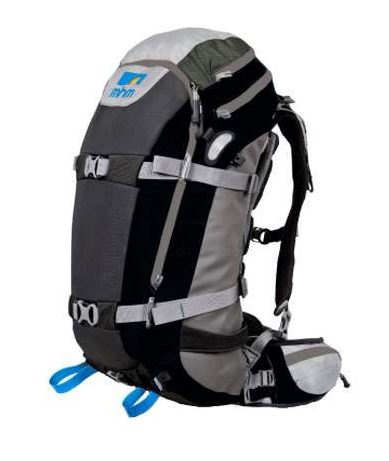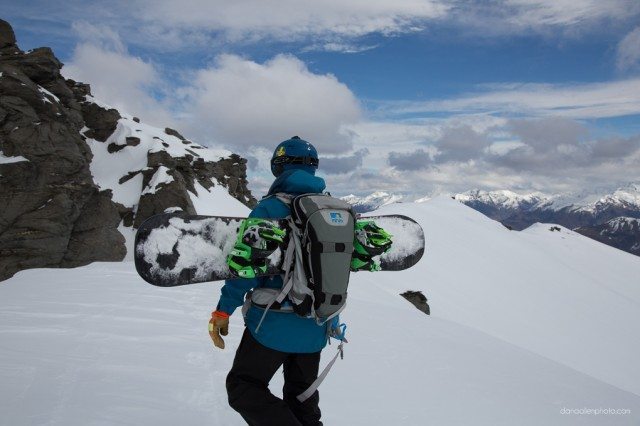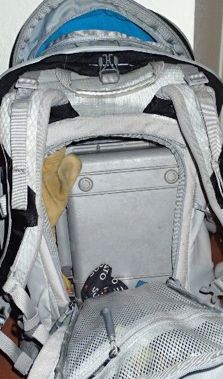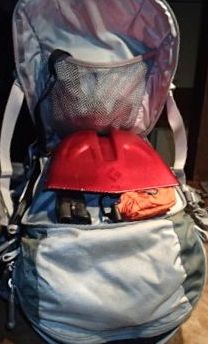
MHM PowderKeg 32
Volume: 32 liters
Weight: 3lb 80z
Features:
- M-Flex Access suspension system
- VariCant dual-pivoting, adjustable hipbelt
- VersaHaul snowboard & ski carry system
- EPO reinforced front and side-panels
- Large organized shovel & snow tools pocket
- 10 pockets + main compartment
- 4 poly-tube gear loops
Reviewer Info: 5’10”, 165 lbs
- Waist Size: 31 inches
Days Tested: 28 days
Locations Tested: Taos Ski Valley; Canterbury club fields, Treble Cone, and Mt. Ruapehu backcountry, New Zealand
Intended for both skiers and snowboarders, the PowderKeg 32 has more storage than you’d expect from a pack this size, and it lets you carry your skis or your board however you want (vertically, diagonally, or horizontally).
Not only does it not discriminate on how you choose to get down the mountain, it also comes with a bunch of other great features. Let’s start with fit.

Fit
The PowderKeg is one of the most comfortable packs I’ve used, and it’s easy to adjust no matter what clothes I’m wearing under it. In the past, I’d struggle with packs that would bounce around while I was snowboarding, and the sudden weight transfers would throw me off balance.
Over the last few years, I’ve used a North Face Patrol 35 and a Black Diamond Anarchist Avalung for freeriding and patrolling. I loved both these packs for various reasons, but the PowderKeg has them beat when it comes to fit and comfort.
I rode with the PowderKeg daily at the Club Fields of New Zealand when I was carrying avalanche gear, extra layers, water, camera lenses, and extra gloves—even with loads up to 35 lbs., I hardly noticed the pack on my back.
Straps
There are two main compression straps across the outside of the pack’s avi pocket. These straps double as part of the carrying system (depending on which method you use), and help keep the pack compact.
I was impressed by how easy it was to strap my board on to this pack, and I appreciate the versatility the PowderKeg offers when it comes to carrying either skis or a snowboard in a variety of ways.
Storage
The PowderKeg’s 32-liter interior is strategically organized to carry what I need for a day of freeriding or patrolling.
There’s a dedicated avi tool pocket, a top zippered compartment, and a main compartment that can be accessed both from the top and from the rear (very useful). The top pocket was just large enough to hold a few small, miscellaneous items, including a digital hand-held camera and a kestrel anemometer (or a wind speed measuring tool. Yes, I’m a geek).
Both the avi stow compartment and the main body of the pack have mesh subdivider pockets. There’s also a fleece-lined pocket for goggles at the top of the pack and a waterproof storage compartment on the inside of the rear access panel—perfect for phones or other sensitive electronic items. The PowderKeg will accommodate a hydration bladder, and the hose can be routed on either side of the pack.

My number one gripe with this otherwise very well-designed backpack is the lack of a helmet net. When I tour, I usually like to keep my goggles on my helmet and keep my helmet outside my pack. I would have appreciated a helmet net or another method to keep the helmet secure without having to either hang it from a strap or stuff it inside the pack. I was able to stuff the helmet inside the main compartment with a Pelican Case (24x27x11.5cm), a one liter water bottle, extra gloves, and two pairs of goggles, but on a long day when I’d be packing more gear, the helmet wouldn’t have fit.
- Avalanche Tool Storage
The avalanche tool storage is made up of a main compartment divided by three mesh subdividers for probes and snow saws. It’s separate from the rest of the pack, and can be opened completely with two rubberized zippers that are easy to use even when you’re wearing gloves.
The compartment tapers toward the bottom of the pack, keeping the pack compact and well-balanced. I found that this compartment would accommodate my Black Diamond Flicklock snow saw (about 47 cm), BCA Profile 240 probe (collapsed length—45.75cm), and Black Diamond D3 shovel with the handle on. The larger D7 shovel wouldn’t fit with the handle on and it just barely fit with the handle off.
(Note—The Black Diamond D3 and D7 are two of the most compact avi shovels on the market, so don’t expect this compartment to accommodate much larger shovels. While I imagine the pocket will accommodate most shovel heads, the shafts will likely need to be removed.)
To completely unzip this pocket, I needed to release the main compression straps. But in the case of an actual emergency when you need to access the tools quickly, all you have to do is open the top of the compartment and pull the gear out.

NEXT PAGE: Volume
